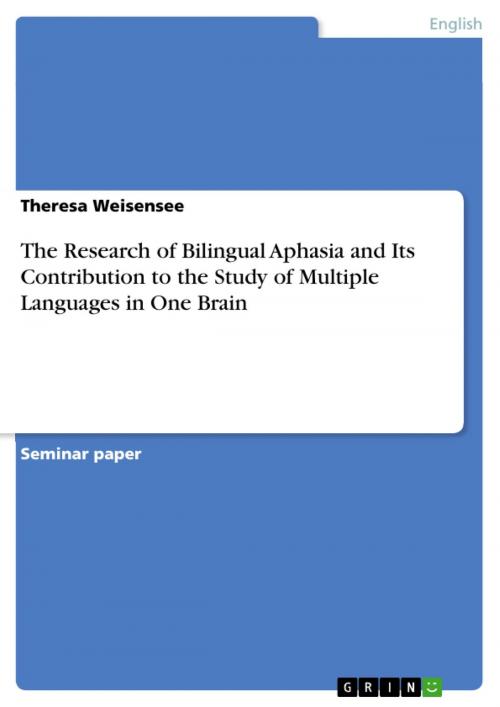The Research of Bilingual Aphasia and Its Contribution to the Study of Multiple Languages in One Brain
Nonfiction, Entertainment, Drama, Anthologies| Author: | Theresa Weisensee | ISBN: | 9783640601103 |
| Publisher: | GRIN Publishing | Publication: | April 22, 2010 |
| Imprint: | GRIN Publishing | Language: | English |
| Author: | Theresa Weisensee |
| ISBN: | 9783640601103 |
| Publisher: | GRIN Publishing |
| Publication: | April 22, 2010 |
| Imprint: | GRIN Publishing |
| Language: | English |
Seminar paper from the year 2007 in the subject English Language and Literature Studies - Linguistics, grade: 1.0, Justus-Liebig-University Giessen, language: English, abstract: At present, approximately two thirds of the world's population is bilingual. Globalisation, migration and decreasing gaps between different cultures and countries make the ability to speak two or more languages necessary, and, consequently, the number of bilingual people increases steadily. The ever-increasing, significant number of people speaking two or more languages has caused high interest, among psychologists, educators and also psycholinguists, in the cognitive and cerebral study of the bilingual. An important part of the research is the study of bilingual aphasia, meaning the loss of the capability to comprehend and/or speak a language, either totally or in part, which is a result of brain injuries often caused by diseases, such as strokes or tumours, war injuries or car accidents (cf. Myers-Scotton 2006: 317). Studying bilingual aphasia and its impacts on the bilingual's different languages contributes to finding an answer to the question of how two or more languages are organised and represented in the brain. In so doing, this field of research posits hypotheses concerning the cerebral organisation of language in general and the parts of the brain which function for its production. After having defined the terms bilingualism and bilingual, which is a necessary prerequisite to avoid confusing ambiguities in the following text, this essay will illustrate the most common patterns of language recovery and their relative incidence. This illustration will be followed by an overview of early suggested and attempted explanations for the questions about which brain mechanisms are responsible for the various patterns, why a certain patient shows a certain recovery pattern and why one language in some cases remains more intact than the other, or why sometimes one is preserved, while the other is lost entirely. Finally, the essay will outline the findings of recent research and their contribution to the cognitive study of language.
Seminar paper from the year 2007 in the subject English Language and Literature Studies - Linguistics, grade: 1.0, Justus-Liebig-University Giessen, language: English, abstract: At present, approximately two thirds of the world's population is bilingual. Globalisation, migration and decreasing gaps between different cultures and countries make the ability to speak two or more languages necessary, and, consequently, the number of bilingual people increases steadily. The ever-increasing, significant number of people speaking two or more languages has caused high interest, among psychologists, educators and also psycholinguists, in the cognitive and cerebral study of the bilingual. An important part of the research is the study of bilingual aphasia, meaning the loss of the capability to comprehend and/or speak a language, either totally or in part, which is a result of brain injuries often caused by diseases, such as strokes or tumours, war injuries or car accidents (cf. Myers-Scotton 2006: 317). Studying bilingual aphasia and its impacts on the bilingual's different languages contributes to finding an answer to the question of how two or more languages are organised and represented in the brain. In so doing, this field of research posits hypotheses concerning the cerebral organisation of language in general and the parts of the brain which function for its production. After having defined the terms bilingualism and bilingual, which is a necessary prerequisite to avoid confusing ambiguities in the following text, this essay will illustrate the most common patterns of language recovery and their relative incidence. This illustration will be followed by an overview of early suggested and attempted explanations for the questions about which brain mechanisms are responsible for the various patterns, why a certain patient shows a certain recovery pattern and why one language in some cases remains more intact than the other, or why sometimes one is preserved, while the other is lost entirely. Finally, the essay will outline the findings of recent research and their contribution to the cognitive study of language.















